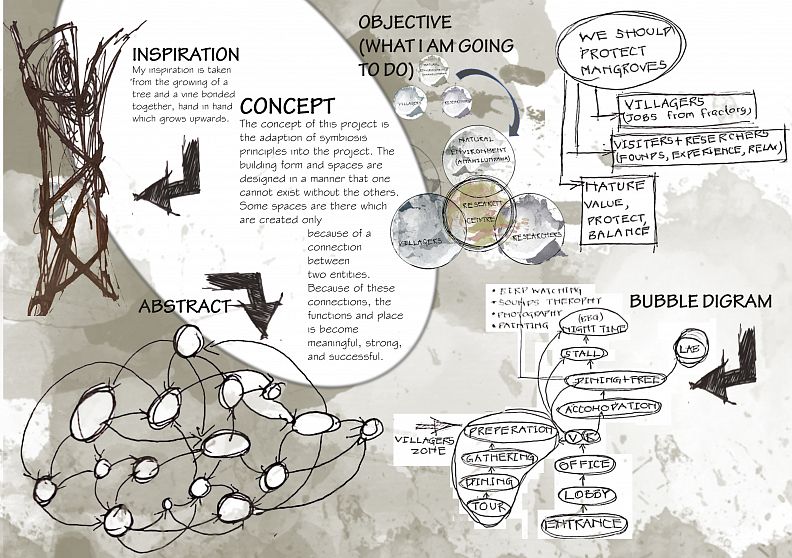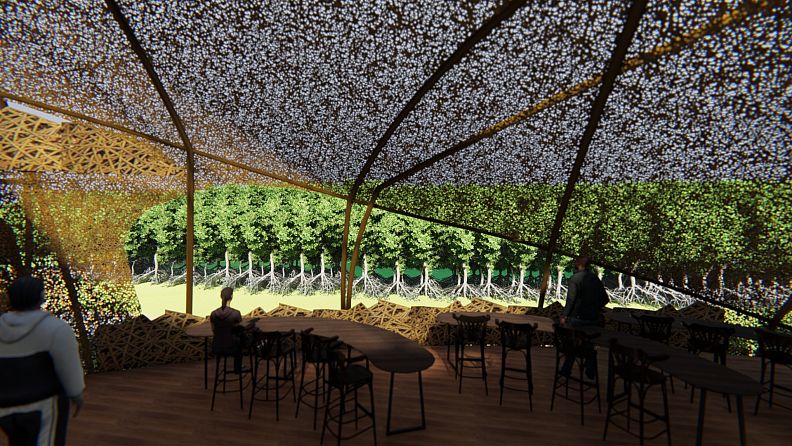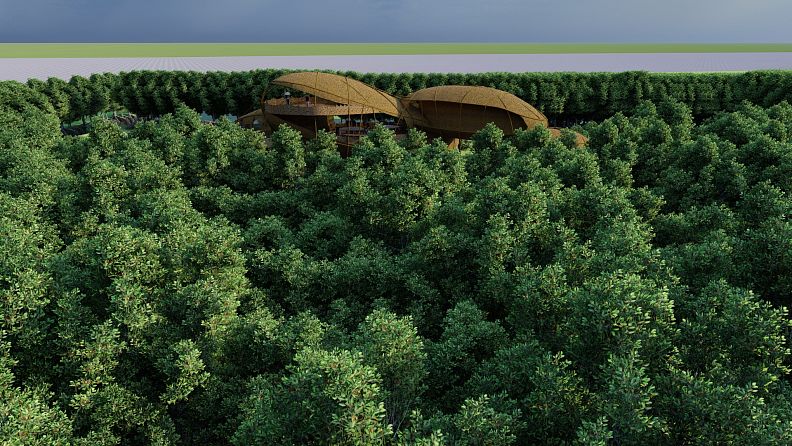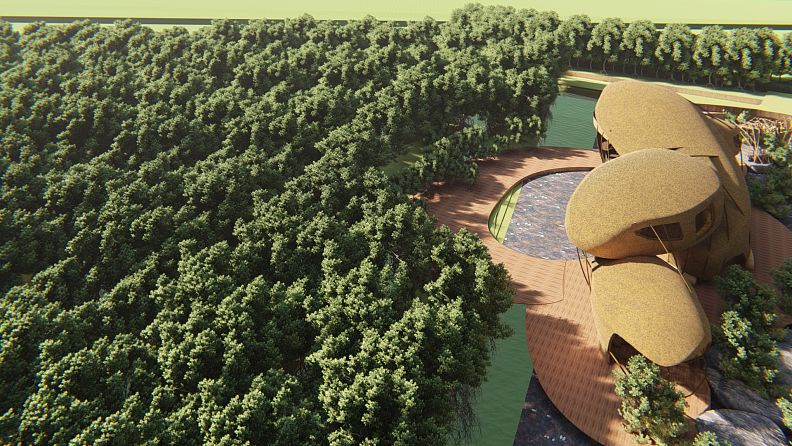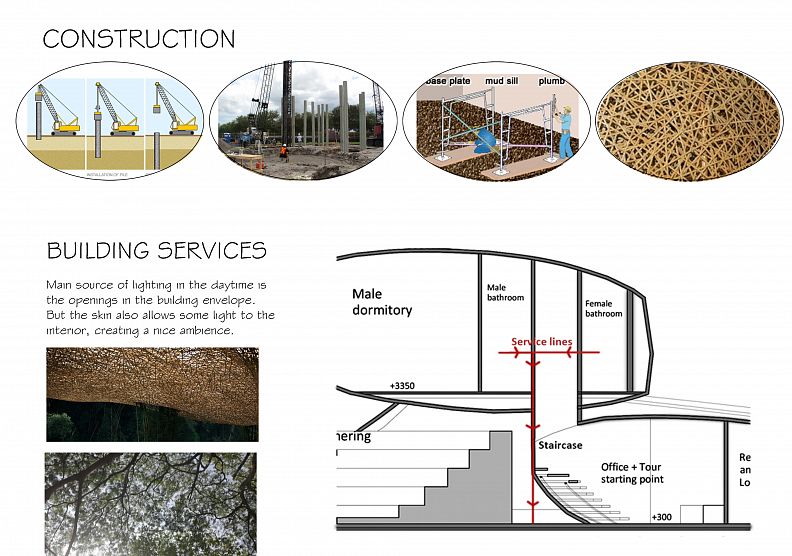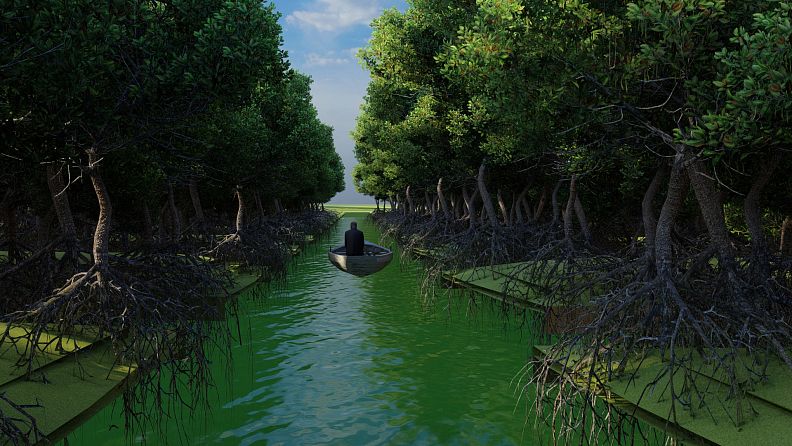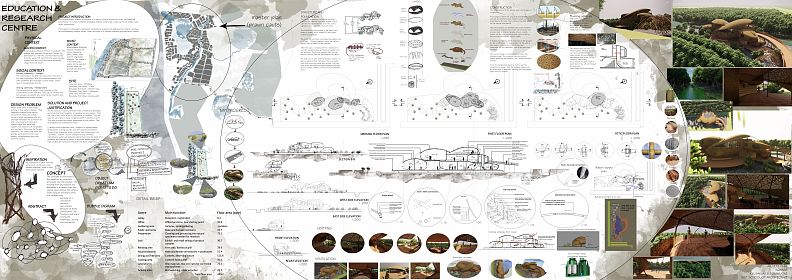Research center and Education center, Anawilundawa bird sanctuary

Project idea
PROJECT IDEA
Anawilundawa wetland reserve is one of the most controversial natural ecosystems in Sri Lanka. The reason for that is the fact that this was created because of humans, partially destroyed because of humans, and then again on its way to be conserved - by human intervention.
This Anawilundawa wetland ecosystem is protected under the RAMSAR Convention, which is UNESCO's international convention on wetlands. It is also a complex natural habitat comprising a wide variety of wetland and other ecosystems. The project is intended to generate architectural solutions to address the climate, ecology, and sustainability related issues.
LOCATION AND SITE
Anawilundawa sanctuary is not a single ecosystem, but a collection of natural wetland habitats like marshes, mangroves, salt marshes and man-made features like tanks, canals, paddy lands and prawn farms.
This is a unique wetland in not only Sri Lanka but in the whole South Asian region. There are mainly seven tanks, which covers an approximate area of 188 ha which sustains about 412 ha of traditional paddy cultivation. The natural vegetation patches are dispersed among these tanks and paddy fields. The seasonally flooded areas of the tanks in the sanctuary are the biodiversity hotspots.
Project description
DESIGN APPROACH (IDENTIFIED PROBLEM)
The social context of this project acts as the main generator for the design. In there, three main entities are identified.
1. Local community
They can be identified as an underdeveloped community, with many problems like shortage of clean water, strict laws of conservation affecting many activities they do, and etc.
2. Outsiders
In the existing situation, wildlife conservation department members and other environmental workers visit the sanctuary, and they can be identified as the second social group which their sole purpose is the conservation of this wetland. They can be divided into two groups, as people who come to do research and the people who come to learn.
3. Natural Environment
Between the above groups, there is the vulnerable natural ecosystem of Anawilundawa wetland. The actions of both above entities affect this entity and the things happening in this entity also affects the other two.
DESIGN RESPONSE
By the program of this project,
• the nature must be preserved.
• The researchers must be able to study something new,
• and the villagers must be able to get an income.
Or simply, the project must fulfill everyone's needs
An ecosystem is established mainly by natural vegetation. So, if we grow mangroves here, firstly they can research about mangroves in the research center. Through that research, new productions can be made. The needed scientific knowledge will be found here, but the production will be done at a different place. The local people who worked in the prawn farms before can take part in this production process. That will solve the economic issues they had.
Another thing is that newly grown mangroves also will turn into biodiversity hotspots. This will attract birds and other animal species, giving more chances for research and education.
So, by growing mangroves, villagers will have an income source, Researchers will have more chances to explore and experience the wetland environment, and because of them the value of the nature will increase and automatically it will be protected.
SOLUTION AND PROJECT JUSTIFICATION
As a solution to this problem, the three organisms which is mentioned above can continue their interaction in a “symbiotic” manner. But to change the way of those interactions, some well-planned intervention must be done.
The said intervention must be a critically important one for all three entities. Among the four projects, research and education center is the one that is mostly connected with the problem we are tackling here. That is because this project is strongly dependent on the context unlike other projects. Therefore, the research and education center is the best suitable project to do that. It will be the added organism that creates the symbiosis between the three organisms.
PROJECT THEME
Symbiosis is the interaction between many different organisms living in the same environment, in a way that their interactions result in advantages for all of them. The latter part is crucial because symbiosis must always be advantageous for all the involved parties, without doing any harm.
INSPIRATION
Symbiosis is also observable in the natural environment of the context. The natural elements like shrubs, branches and roots in the dry-zone-wetland ecosystem are connected together. The trees, with the small branches and twigs have an appearance like they are growing to connect with each other. Also, the trees and vines grow together in symbiosis. With those elements binding together, the ecosystem has the aesthetic beauty that gives life to the nature.
The social context also represented that quality as the village people lived well connected with each other. The few villages which were in the area bonds together, becoming one lively community.
DESIGN CONCEPT
The concept of this project is the adaption of symbiosis principles into architecture The building form and spaces are designed in a manner that one cannot exist without the others. First, this is expressed in a structural manner, where one capsule cannot stay upright without the support from the others. Second, the spaces only have a meaning when they are connected to the other spaces, even if they are inside separate capsules.
Also, there are "leftover spaces" which are created between two capsules, created because of the connection between those capsules. Because of these connections, the functions and spaces become meaningful, strong, and successful.
The building takes the form of five capsules, placed on the ground by resting upon one another, like five round balanced stones. These capsules look like if one falls, all the others will fall down. No strict order can be seen in the placement of these capsules, which enhances the organic quality. These capsules also take irregular forms and shapes, where the middle part is vertically flatter than the top and bottom parts. Both the existing and projected look of the natural environment around the site, is a forest of mangrove trees with different sizes of large, round and leafy crowns. The above said form perfectly fits this quality of the nature, when seen from the external expression of the building.
The next environmental quality observed is the mesh like appearance when going under the tree canopies. This dry zone ecosystem is characterized by the little elements like twigs, thin leaves, roots and vines entangle and grow very close to create a beautiful space under the canopies. This beauty is doubled by the light effect created by sunlight which gets filtered through the hollow canopy.
The use of a hollow building skin with woven bamboo stripes tries to inspire from this quality to create the intended interior environment in the design. The spaces are covered for the most part, but the perforated skin helps to have a good natural lighting and ventilation without heating the interior.
CLIENT - Forest Department of Sri Lanka
Protecting mangroves is a state policy which is recently added. One of the main objectives of this research center project is protecting the mangrove ecosystem. The researches done in this environment reveals more unknown facts about the mangrove ecosystem, potentially increasing the value of it. The project will be funded from the government, via the forest department. The construction and operation of the building involves the village community too. This being a government project will make the community involvement more successful.
Technical information
STRUCTURE AND FOUNDATION
The design comprises a structure with five capsules of different sizes and shapes. The 5 capsules have load bearing steel ribs. Every capsule is also supported by each other.
This structure is more heavy in the base which makes it stable, and it enables to have large cantilevered lengths.
The steel ribs are then surrounded by bamboo ribs of 50mm - 100mm diameter, which are used to achieve the curvature of the capsules.
After this layer, a translucent PVC membrane is used for waterproofing and thermal insulation for the interiors. This is only applied from the top, before covering with the final bamboo skin layer.
The final layer is built with thin bamboo stripes, of approximately 20mm thickness. This is a double layer from both the inside and outside. This skin layer binds the whole envelope together and also gives a certain stability to the structural members used.
CONSTRUCTION
This construction of this design uses two stages of completion. First stage is where the structure is built with precast and prefabricated elements which are assembled in the site. That will have the least effect on the natural environment. The precast piles and prefabricated steel members can easily be transported to the site from the main access road. Machines like pile drivers, mobile cranes will use the existing access paths used by the excavators used to dig the canals. A temporary padding will be required on the ground for the scaffoldings to stay upright. At the end of this stage, construction of the floors and staircases will be completed, with all the services installed. The second stage of construction involves the finishing stage. The materials used are mostly natural materials like Bamboo, cob, granite and jute strings First, the bamboo ribs layer is built to get the complete curvature. Then the bamboo stripes will be layed upon it randomly, weaving and intertwining them with one another.
BUILDING SERVICES
Main source of lighting in the daytime is the openings in the building envelope. But the skin also allows some light to the interior, creating a nice ambience.
The design does not use service ducts. Instead, tubes can run inside the hollow space inside the two interior and exterior skin layers. In the instances where they are moving from upper level to lower level, they will run through the staircase cavity walls which are vertical.





